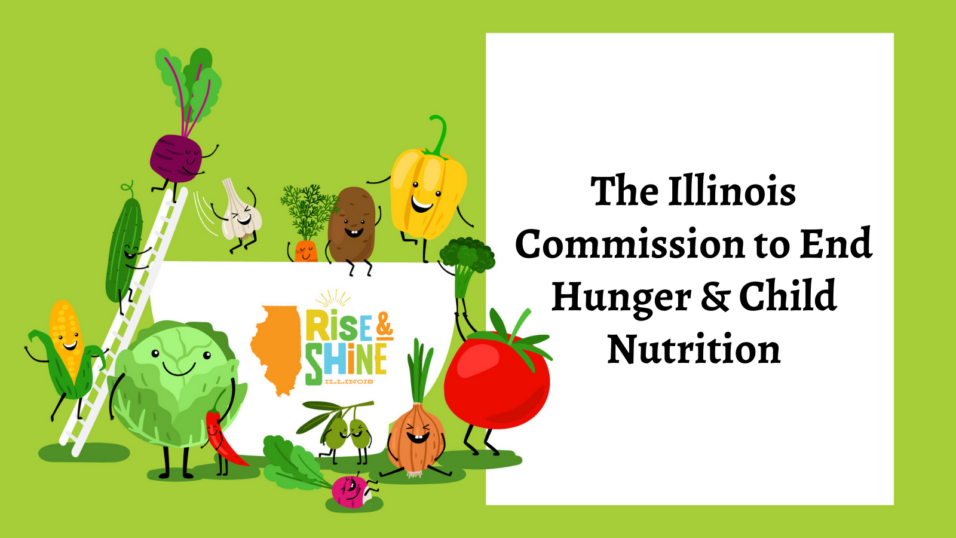Around the state of Illinois, millions of people experienced financial and food insecurity because of the Covid-19 pandemic. The Illinois Commission to End Hunger seeks to alleviate the barriers to accessing social services and ensure food equity for all. Our conversation with Colleen Burns, the Greater Chicago Food Depository’s State Engagement and Policy Innovation Lead, talks about the roadmap to take us there and what the next steps are for ending hunger in Illinois.
Responses are edited for brevity and clarity.
Can you tell us a little about the Illinois Commission to End Hunger?
The Illinois Commission to End Hunger was created in 2010 with the intent to bring together a diverse group of stakeholders to identify action items for how to end hunger in our state. The Commission is comprised of public, private, and non-profit leaders from all over the state. And the idea is to ensure cross-collaboration among government entities and community partners toward the shared goal of ending hunger in Illinois.
The three focus areas of the Illinois Commission to End Hunger are technology, innovation, and collaboration. How were those themes selected?
The Commission spent the latter half of 2020 taking time to understand the new landscape under which we were operating, with the pandemic in full swing. So, we did statewide listening sessions, two briefings for the general assembly, and client focus groups to better understand how hunger was impacting our communities. The culmination of this effort was a report that was released in March of this year called “From Food Insecurity to Food Equity” and it’s really a roadmap for the Commission and other stakeholders to use on how to address hunger in our state. The report lays out that we have all these wonderful and effective federal nutrition programs in Illinois. And we saw them be very successful during the pandemic as the need started to increase exponentially. The federal nutrition programs were there to meet that increase in need. And so, in the short term, we need to be doing a better job of connecting those individuals to federal nutrition programs and making sure that when they approach one program that we really take that opportunity to say, “Hey did you know you may be eligible for this?” And then of course in the long term, we can’t have any conversations about ending hunger without addressing the root causes of poverty and racial inequity. The roadmap sets out three strategies for doing that: technology, innovation, and collaboration.
What specific child nutrition programs or policy initiatives is the Commission looking to support or work on?
Great question- lots! One of the priorities of the Commission to End Hunger is looking into having the state of Illinois develop a statewide application for free and reduced-price school meals. Currently, every school district does that a little bit differently. We’d really like to see Illinois have one centralized location online for an application for free and reduced-price school meals. The other thing I would mention is that we’re also looking at our summer text line where individuals can learn more about what open summer feeding sites there are in their area, and perhaps adding on available afterschool programs to that text line.
Can you identify one or two most pressing child nutrition issues at this time, given the pandemic and all the administrative changes?
Breakfast! The Commission to End Hunger has been, since its inception, looking at how we increase school’s implementing a breakfast program. We know that there are many less students who participate in breakfast than lunch, and we’d really like to increase our numbers of school districts that are implementing Breakfast After the Bell. The challenge of course is that in these uncertain Covid times, schools are certainly dealing with a lot. But this is a perfect moment in time to think creatively and leverage some of the flexibility that we have been granted during the pandemic to feed kids in our school buildings. Obviously, every school is going to do that in the way that best serves their students, but the Commission would really like to continue to support and encourage more school districts to implement Breakfast After the Bell.
As you mentioned, because of the pandemic there’s been so much heightened flexibility that really allowed people to be very nimble in creating programs that reach more students and children. What would you say is a recent child nutrition policy success in Illinois?
The first thing I’d say would be the state-wide implementation of Pandemic-EBT, which was a program that replaced the value of school meals for kids who were not in school during the pandemic and provided them with an electronic card which they could use to purchase groceries. We reached more than one million children in Illinois, and I don’t think we can understate how important that program was during the pandemic for feeding kids.
What do you think people can do to get more involved in support the Commission’s work to end hunger?
First thing would be to look at the Roadmap to End Hunger, which lays out all the recommendations the Commission has for how we can end hunger in our state. We have a website, endhungerillinois.org, where the report is available. The other thing I would recommend is getting involved with your local food pantry. If you have the opportunity to volunteer, that’s a great place to start.
To learn more about the Illinois Commission to End Hunger and read From Food Insecurity to Food Equity: A Roadmap to End Hunger in Illinois, visit endhungerillinois.com



